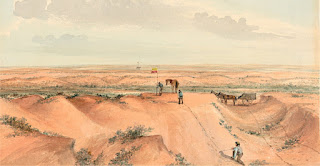I have no book to write at the moment, so I am messing with a few leftovers that never made it into books,
How do you work out how far you have travelled? Watkin Tench tells us that Lieutenant Dawes was skilled at counting paces, while later parties, when they had competent surveyors along, were able to pinpoint themselves on the map, and so measure how far they had travelled by triangulation. In other cases, they used a curious surveying instrument called a perambulator, which was not for the carriage of babies, but a sort of wheelbarrow with a counter attached, a later version of the odometer that was used by the Romans to measure the lengths of roads using cogged wheels.
To take a simple example, a standard adult bicycle has a
28-inch wheel (there is method in my using these old units, as you will see).
That converts to a circumference of 88 inches, which means that three rotations
cover 22 feet, and nine cover 22 yards, one chain. A device that counts the rotations
of such a wheel will record a mile for every 720 revolutions. If our explorers
keep the perambulator going, they can keep track of the distance and direction
every thirty minutes or so, and record that on a traverse board that summarises
the morning's journey.
The traverse board of the sailors was a board with holes
and pegs on strings (to stop the pegs being lost). One part was a compass rose,
and each half hour of a four-hour watch, a peg would be placed to summarise the
direction during that time, while a second peg would record the speed in knots.
It was possibly this nautical device that the marines took into the bush, along
with the counting Lieutenant Dawes, and it is likely that others used the
traverse board or a similar method of summarising their travels in a visual
form.
There is, however, some doubt as to what Tench meant,
because he actually refers to a 'traverse table'. While we have seen that
boards and tables are inextricably linked in the English language, the traverse
board with its pegs was different from the traverse table, which was a set of
figures in a printed table that could be used to calculate the days' travel
from the sort of data that could be recorded on the traverse board.
Incidentally, on board ship, the rough log where details were chalked each
watch was commonly a hinged pair of boards.
What we do know for certain is that the early travellers
kept a track of the direction they travelled by counting paces, that they
recorded this in some way, and combined the distances and directions to produce
a rough map of where they had been. These days, of course, you just let the GPS
system take regular note of your position at regular intervals, so it can draw
you a downloadable sketch of your path. complete with latitude and longitude.
Major Mitchell had chainmen going continuously, measuring distances covered, all along his route, others, as we have seen, managed quite well with the occasional baseline and triangulation, interpolated with the occasional highly reliable measure of latitude and longitude.

No comments:
Post a Comment